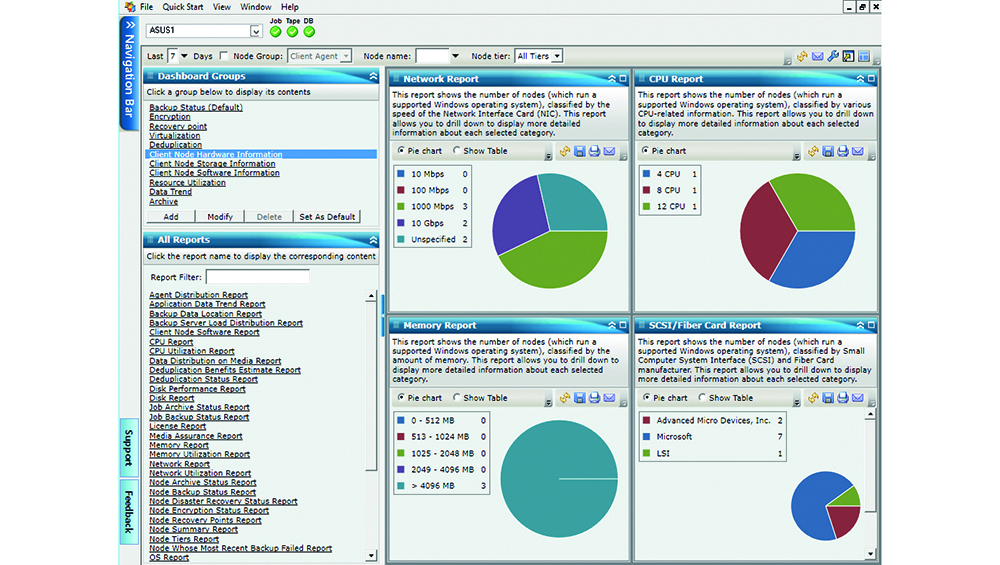Arcserve Backup 16.5 review
Consistent design, ease of use and plenty of data-protection features make this great value


Arcserve Backup is one of the longest-serving backup products on the market, and it still sets high standards for data-protection features. Its central console makes management a cinch, while its component- and capacity-based licensing schemes keep it affordable for SMBs.
-
+
Big storage savings; Cloud storage support;

Arcserve Backup scores highly for consistency despite its numerous upgrades, its central management console has retainedthe same form and feel for many years. New users will love its simplicity, and users of older versions won't be faced with a daunting learning curve.
However, plenty has changed underneath: Arcserve Backup has grown into a total backup solution for securing all your servers, applications and virtualised environments. It can archive to the cloud, works hand in glove with Arcserve UDP appliances, and is the only backup package that includes integral data deduplication in the standard price.
All the action takes place within the intuitive Manager console, which makes the backup process simple. Once we'd pushed all the relevant agents to our test systems, they popped up ready for action in the backup source window.
We were able to browse machines, select specific folders and files, pick Hyper-V VMs and choose our SQL Server 2014 databases. Our Exchange 2013 server was also listed, with the mailbox databases and mailboxes appearing as separate entities under their own organisational folder in the same tree.
Hyper-V host-level backups simply require the Windows agent to be loaded on the host system: one agent licence lets you back up any number of guest VMs. For file-level backups and restores, an agent is loaded within each VM, which appear in the source view along with their virtual volumes.
For standard protection strategies, you can pick from full, incremental and differential backups. You can use built-in rotation schemes, apply encryption and decide where to back up the data. Arcserve Backup works with tape drives, libraries, virtual tape libraries, local disks, NAS shares and IP SANs.
There's cloud storage support too, extending to Amazon Web Services, Microsoft Azure, Eucalyptus and Fujitsu Cloud, but these can only be used as part of a disk-to-disk-to-cloud (D2D2C) staging and data-migration strategy. We had no problems using our Amazon Web Services account and created virtual storage devices that linked up to our cloud buckets.
The deduplication feature is a cinch to use. Once we'd created a new backup device, we could place the data and index files on separate local or remote locations. Arcserve makes no specific claims about its data-reduction ratios, so we turned to the Binary Testing deduplication test suite to find out.
Using a 4GB dataset of 1,000 files, we introduced controlled changes within a percentage of the files throughouta standard weekly backup strategy. After a one-month simulation, we saw an impressive reduction ratio of over 8:1 so for typical business backup, you can expect big storage savings.
Data restoration is easy. You simply select backed-up systems from the Manager console, pick files and folders, and click to restore them to the original location or another destination. The same process can be used for other sources such as SQL databases, and we could restore either our entire Exchange 2013 database or individual mailboxes, folders and messages.
You can keep a close eye on the action via the Dashboard, which offers a wealth of information, including status reports on backup jobs, client nodes and encryption,as well as reports on backup data distribution, volume usage, media- assurance operations and backup servers.
If you're using deduplication, it also provides reports and graphs on projected storage savings. Arcserve Backup is one of the longest-serving backup products on the market, and it still sets high standards for data-protection features. Its central console makes management a cinch, while its component and capacity-based licensing schemes keep it affordable for SMBs.
This review first appeared in PC Pro magazine issue 254
Verdict
Arcserve Backup is one of the longest-serving backup products on the market, and it still sets high standards for data-protection features. Its central console makes management a cinch, while its component- and capacity-based licensing schemes keep it affordable for SMBs.
REQUIREMENTS
Backup server
Windows Server 2003 upwards
Get the ITPro daily newsletter
Sign up today and you will receive a free copy of our Future Focus 2025 report - the leading guidance on AI, cybersecurity and other IT challenges as per 700+ senior executives
Dave is an IT consultant and freelance journalist specialising in hands-on reviews of computer networking products covering all market sectors from small businesses to enterprises. Founder of Binary Testing Ltd – the UK’s premier independent network testing laboratory - Dave has over 45 years of experience in the IT industry.
Dave has produced many thousands of in-depth business networking product reviews from his lab which have been reproduced globally. Writing for ITPro and its sister title, PC Pro, he covers all areas of business IT infrastructure, including servers, storage, network security, data protection, cloud, infrastructure and services.
-
 Westcon-Comstor and Vectra AI launch brace of new channel initiatives
Westcon-Comstor and Vectra AI launch brace of new channel initiativesNews Westcon-Comstor and Vectra AI have announced the launch of two new channel growth initiatives focused on the managed security service provider (MSSP) space and AWS Marketplace.
By Daniel Todd Published
-
 Third time lucky? Microsoft finally begins roll-out of controversial Recall feature
Third time lucky? Microsoft finally begins roll-out of controversial Recall featureNews The Windows Recall feature has been plagued by setbacks and backlash from security professionals
By Emma Woollacott Published
-
 The UK government wants quantum technology out of the lab and in the hands of enterprises
The UK government wants quantum technology out of the lab and in the hands of enterprisesNews The UK government has unveiled plans to invest £121 million in quantum computing projects in an effort to drive real-world applications and adoption rates.
By Emma Woollacott Published